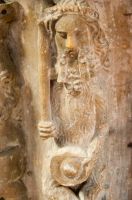
The tower and west door was finished around 1430. The 15th-century tower and church were almost certainly financed by the Argentein family, whose coat of arms, a trio of covered cups, appear inside the church, on the north porch, and on a buttress supporting the Lady Chapel.
Inside, the 15th-century font is particularly interesting; on the base are four woodwoses, the Suffolk wildman of the woods, bearing his club. Each woodwose is depicted in a different pose, alternating with figures of lions. The Argentein family arms appear on one of the four heraldic shields on the font bowl.
Under the piscina on the south wall is a set of three 'Danestones', pre-Conquest carved stones that appear to be-be Scandinavian in origin. These may date to as early as the 9th century and were likely part of the Saxon church on this site.
There are several interesting brasses in the church; on the south pier of the tower arch is a late 15th century brass to John Everard (d. 1476), while on the opposite pier is a brass to William Fyske (d. 1512). In the south aisle is a brass to John Browne (d. 1581) set on the reverse of an earlier Flemish brass.
There is a mid-17th-century hatchment to James Keble in the vestry and a painted wooden panel to Richard Asshelton (d. 1641) in the chancel.
On the wall by the south porch, is a plaque commemorating Sir Joseph and Sir William Hooker, founders of Kew Gardens, and nearby in the floor by the font is a small tablet to Charles D'Urban, brother to Sir Benjamin D'Urban after whom the city of Durban, South Africa is named.
There are numerous examples of attractive timber-framed houses surrounding the treed churchyard.












 We've 'tagged' this attraction information to help you find related historic attractions and learn more about major time periods mentioned.
We've 'tagged' this attraction information to help you find related historic attractions and learn more about major time periods mentioned.


